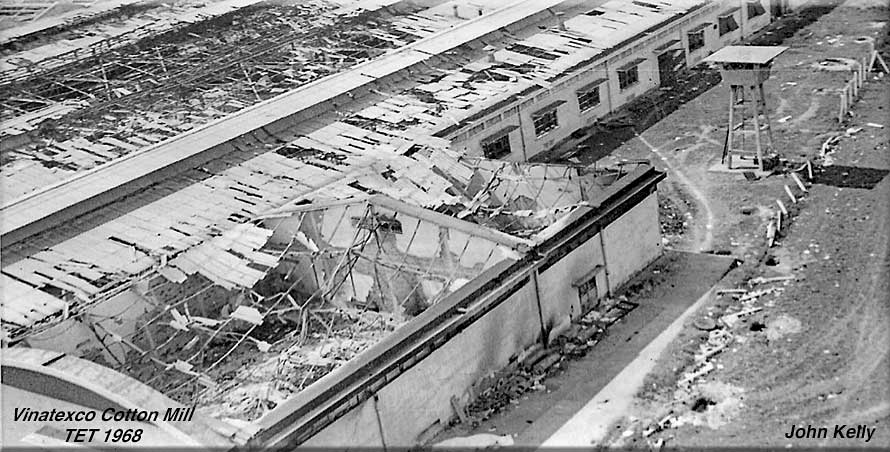

The Vinatexco Textile Factory - Tet 1968
John Kelly - (ref 1, ref 2, ref 3)
also see Pat Eastes "Year of the Rat"
………………………………………………………………………………………………………………………………………
On Jan 31st, C Troop was heading to Ton Son Nhut Air Base to help in a defense from an enemy assault. Enroute, C Troop was ambushed and suffered heavy casualties. As we stood around the Ops center listening to the radio, we were all frustrated and angry due to the heavy fog preventing us from flight. As the morning dragged on and the fog eventually lifted, we took off and rushed to C Troops position. C Troop suffered many, casualties and we saw track after track burning on the road as we flew south.
As we neared Ton San Nhut airbase, we could see hundreds of the enemy out in the open, something heretofore not normally observed. I requested recurring artillery fire and we then diverted to the Vinatexco building (photo below) where the enemy was entrenched. I adjusted artillery fire into that structure along with gunship and airforce strikes totally destroying it. (Note the prepared foxholes outside the fence)

The Navy Department Library: "Tet: The Turning Point in Vietnam"
At 0300 on 31 January 1968 the enemy attack began with the explosion of the ammunition dump next to Weyand's II Field Force headquarters at Long Binh north of Saigon. Between 0300 and 0500, Oberdorfer reported, Weyand "ordered nearly 5,000 mechanized and airborne troops into battle. . . . Mostly to defend United States installations at Long Binh, Bien Hoa Air Base and Tan Son Nhut Air Base."19 The most critical of those battles, perhaps the most critical of the Vietnam War, was the repulse of the enemy attack on Tan Son Nhut. The enemy main assault came from the west. Two VC battalions had infiltrated the city and staged at the Vinatexco cotton mill just outside the air base perimeter. Their initial attack was delayed by Air Force Security Police and two South Vietnamese airborne companies, but they were not strong enough to halt the advance.
At dawn, however, the enemy force was struck on the flank by the 25th Infantry Division's C Troop, 3d Squadron, 4th Cavalry, which on General Weyand's orders had moved overland from its base camp at Cu Chi, some 25 miles to the northwest. They had been guided into their attack position by flares dropped from his helicopter by their squadron commander, Lieutenant Colonel (later General) Glenn Otis.
"Armored vehicles fighting infantry in the open can do frightful damage," noted Professor Eric M. Bergerud in his history of the 25th Infantry Division in Vietnam, "and C Troop did. But they were in over their heads. Their opponents were armed to the teeth with antitank weapons and they greatly outnumbered the Americans. After fierce fighting, C Troop was nearly destroyed." With his A Troop pinned down by an NVA unit, Otis ordered his B Troop to reinforce C Troop. They attacked on line and broke the back of the enemy attack. "We can see in retrospect," Bergerud writes, "that the first day's actions, repeated by other U.S. and South Vietnamese units around Saigon, doomed the [enemy's] attack on the capital."20
Other sources: The 1968 Tet offensive dealt a severe blow to Vietnam's textile industry, causing about US$30 million in damage. Vinatexco's Gia Dinh plant
Declassified: Project Checo Southeast Asia Report
"Forward Air Controllers (FACs) kept the enemy engaged during the entireaction by adjusting artillery and controlling airstrikes, Of note was theengagement at the VINATEXCO textile factory located northwest of Tan Son Nhut.An U.S. Army unit--the 3/4th Cavalry--reported that it was receiving heavysmall arms fire from this factory, Clearance for an airstrike was obtainedand the first ordnance was put in by the VNAF 33d Wing, followed by USAF F-lO0strikes. Large secondary explosions were observed. A follow-up ground sweepof the factory revealed 95 percent destruction and 170 VC body count Total9/VC body count in and around Tan Son Nhut was more than 900."
The BDM Corporation Vol II South Vietnam.
THE BDM CORPORATION2. Tet 1968 and MobilizationThe country-wide wave of enemy offensives, starting with Tet in1968, produced a severe but only temporary setback to the economy of SouthVietnam. Since much of the heavy fighting took place in and near the majorcities and towns, the small but precious light industrial base was damagedseverely; the industrial complexes at Saigon and Bien Hoa particularly wereravaged. It was estimated that 50 to 60 per'ent of the textile productioncapacity was destroyed.35/ For example, after the aborted attack on TanSon Nhut airbase, a major enemy unit took refuge in the nearby VinatexcoTextile plant; both the enemy and the factcries were destroyed by alliedair and artillery attack. The harvest and distribution of rice werehampered by the concentration of RVNAF for the protection of the cities andmajor towns. The offensive also had an adverse impact on the importantfish crop which in the first half of 1968 was 15% lower than in the similarperiod in 1967. For this reason and due to the influx of refugees to theurban areas, fish prices in Saigon in December 1968 were five to six timeshigher than they were in 1965. 36